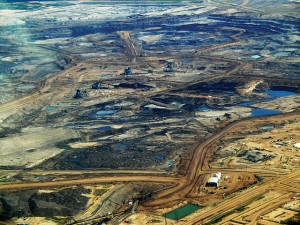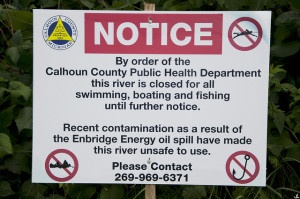We have much more to do and your continued support is needed now more than ever.
Study on the Safety of Transporting Tar Sands Oil Avoids the Tough Questions
The Pipeline and Hazardous Materials Safety Administration (PHMSA) commissioned the National Academy of Sciences (NAS) to perform a study on tar sand oil. The study concluded that tar sands oil (moved as a substance called diluted bitumen) and heavy crude oil present similar pipeline risks. While this may seem newsworthy and appear to allay concerns about tar sands transport, it is no surprise and provides no comfort. This study came in response to a 2011 Congressional request that PHMSA examine the adequacy of its regulations after the tragic July 2010 tar sands spill into the Kalamazoo River. Unfortunately, pipeline safety officials did not ask scientists to examine whether its regulations were adequate. Nor did they request an examination of how tar sands behaves after a spill or whether a major transformation in pipeline use from lighter to heavier, more viscous crude poses greater risk to communities, people and wildlife.

But first, what is tar sands oil and why is different?
Tar sands, unlike other crude oil that is extracted in some liquid form, is an asphalt-like substance called bitumen immersed in sand deposits. Most tar sands deposits are in a section of Alberta roughly the size of Florida (there are other deposits, but Alberta is by far the largest). After an energy- and water-intensive extraction process that often involves strip-mining, the tar-like bitumen is separated from the sands. Being the consistency of peanut butter, it is not able to be pumped through pipes without dilution. Dilution occurs when the substance is mixed—usually with a natural gas condensate—to form a heavy-crude like substance that can be moved through pipes under high pressure, which results in higher temperatures.
Second, what does this study tell us?
Frankly, not much. And that should trouble the many communities that currently face tar sands risks, as well as the ones that will if industry wishes are granted and major pipelines are either built for or converted to tar sands use. More detail can be found here, but, in short, limited movement of similar crude has occurred in U.S pipelines. What we don’t know is what major movement over time would mean, and this new study fails to give us an answer. Heavy crude, especially diluted bitumen, operates at different densities, pressures and temperatures than light and medium crude, and we already know that where diluted bitumen has moved through pipes, spills rates have increased.
So, What Happens After a Spill?
As importantly, the study did not look at how this substance behaves after it spills. As was horribly demonstrated in the Kalamazoo River disaster, when spilled, the bitumen sank in water. While conventional crude floats and can be skimmed from the water surface, the fact that the bitumen sank foiled clean-up efforts and led to widespread contamination. Forty miles of the river were fouled, and after multiple dredging attempts, EPA officials believe the damage may be permanent. The spill, while not the greatest in volume, has proven to be the most expensive on-shore spill at almost a billion dollars and counting. In the recent Transportation, Housing and Urban Development Appropriations Bill, Sen. Jeanne Shaheen (D-N.H.) added a provision that will require PHMA to study the spill properties of diluted bitumen. If this provision becomes law, it would ensure such a study takes place.

Contributing to the [Kalamazoo] accident was the Pipeline and Hazardous Materials Safety Administration’s (PHMSA) weak regulation for assessing and repairing crack indications, as well as PHMSA’s ineffective oversight of pipeline integrity management programs, control center procedures, and public awareness. Contributing to the severity of the environmental consequences were … PHMSA’s lack of regulatory guidance for pipeline facility response planning, [and] PHMSA’s limited oversight of pipeline emergency preparedness that led to the approval of a deficient facility response plan.
Other government agencies have expressed concerns or questions about the readiness to respond to the risk of tar sands, including the Environmental Protection Agency and the Provincial Government in British Columbia. Indeed, British Columbia rejected plans to build a massive tar sands pipeline through the province based largely on spill concerns. If Canada doesn’t want the risk of transporting its own tar sands, why should we?
In sum, the NAS study does nothing to put major concerns about tar sands risks to rest. Kalamazoo and the March 2013 Pegasus pipeline spill in Arkansas sadly demonstrate that the risks of tar sands spills are too high for people, wildlife and communities. Current safeguards are woefully inadequate, and response plans are not up to the task. It’s time for the Pipeline and Hazardous Materials Safety Administration, working in concert with the Environmental Protection Agency, to figure out what protections are needed and put strict new rules in place. In the meantime, we can’t afford to have our natural resources and communities serve as real life testing grounds for how wrong things can go.
![]() Demand accountability and tell the Obama Administration to reject any tar sands development until PHMSA can honestly answer the tough questions about pipeline safety!
Demand accountability and tell the Obama Administration to reject any tar sands development until PHMSA can honestly answer the tough questions about pipeline safety!






















